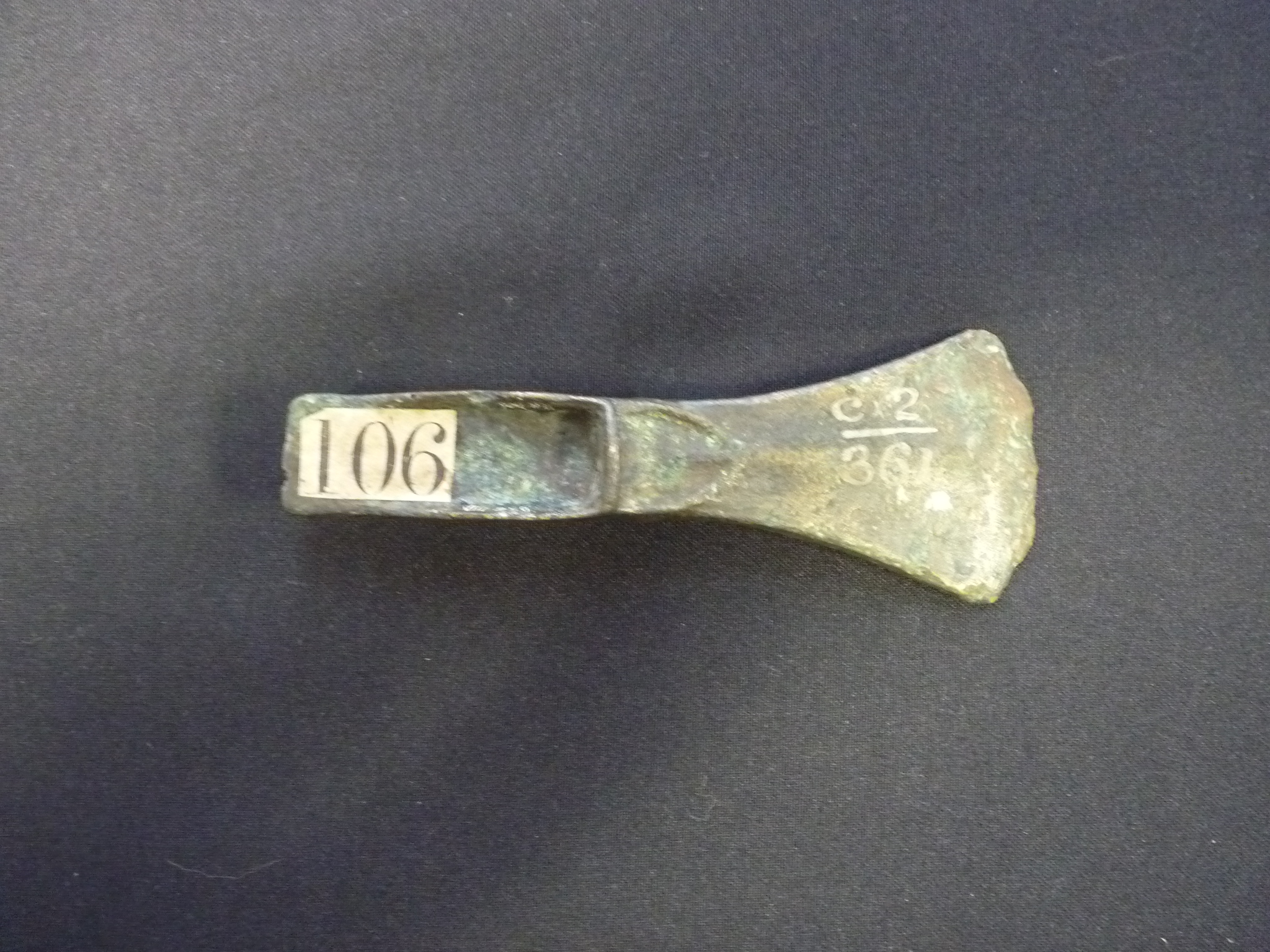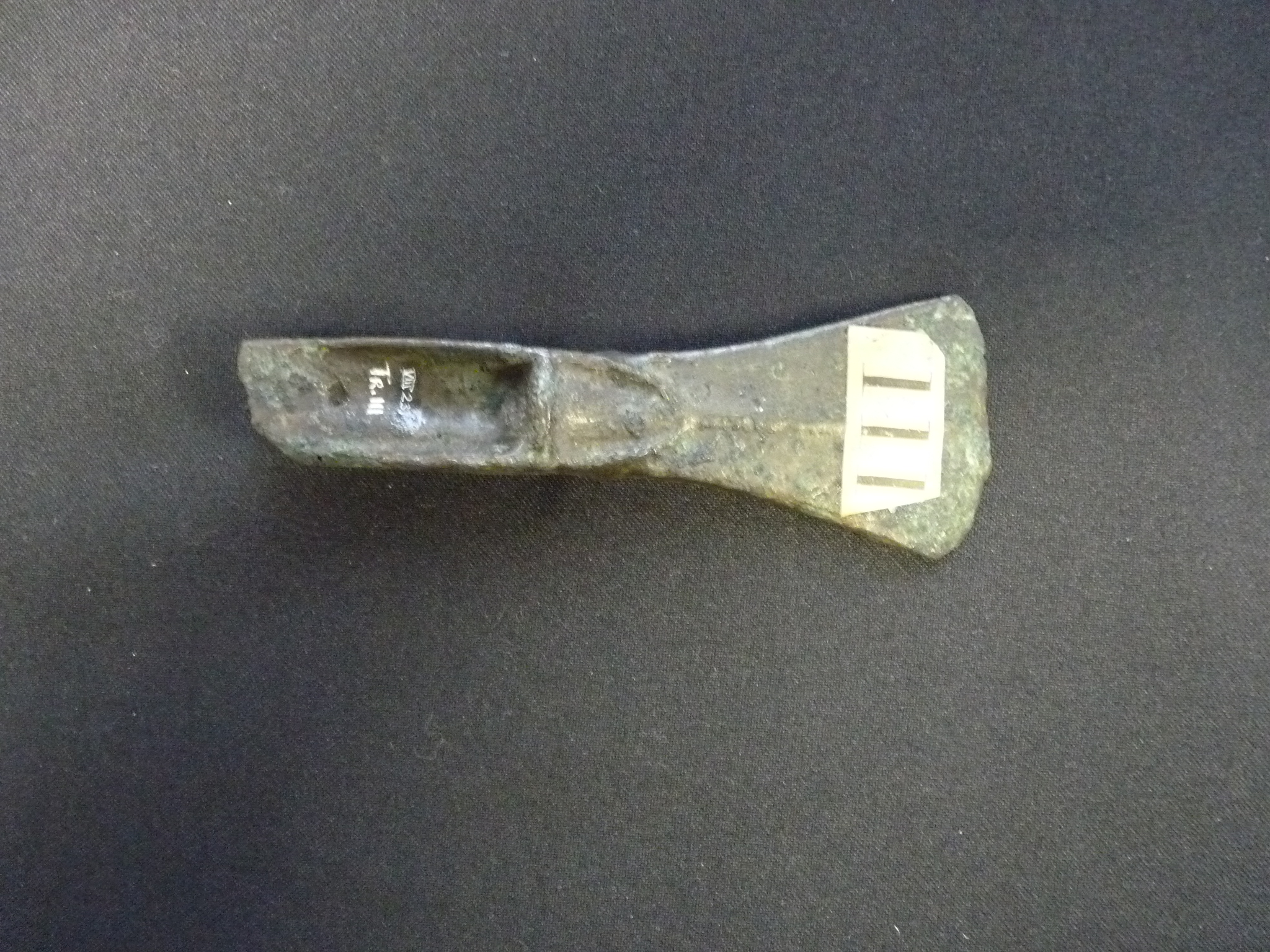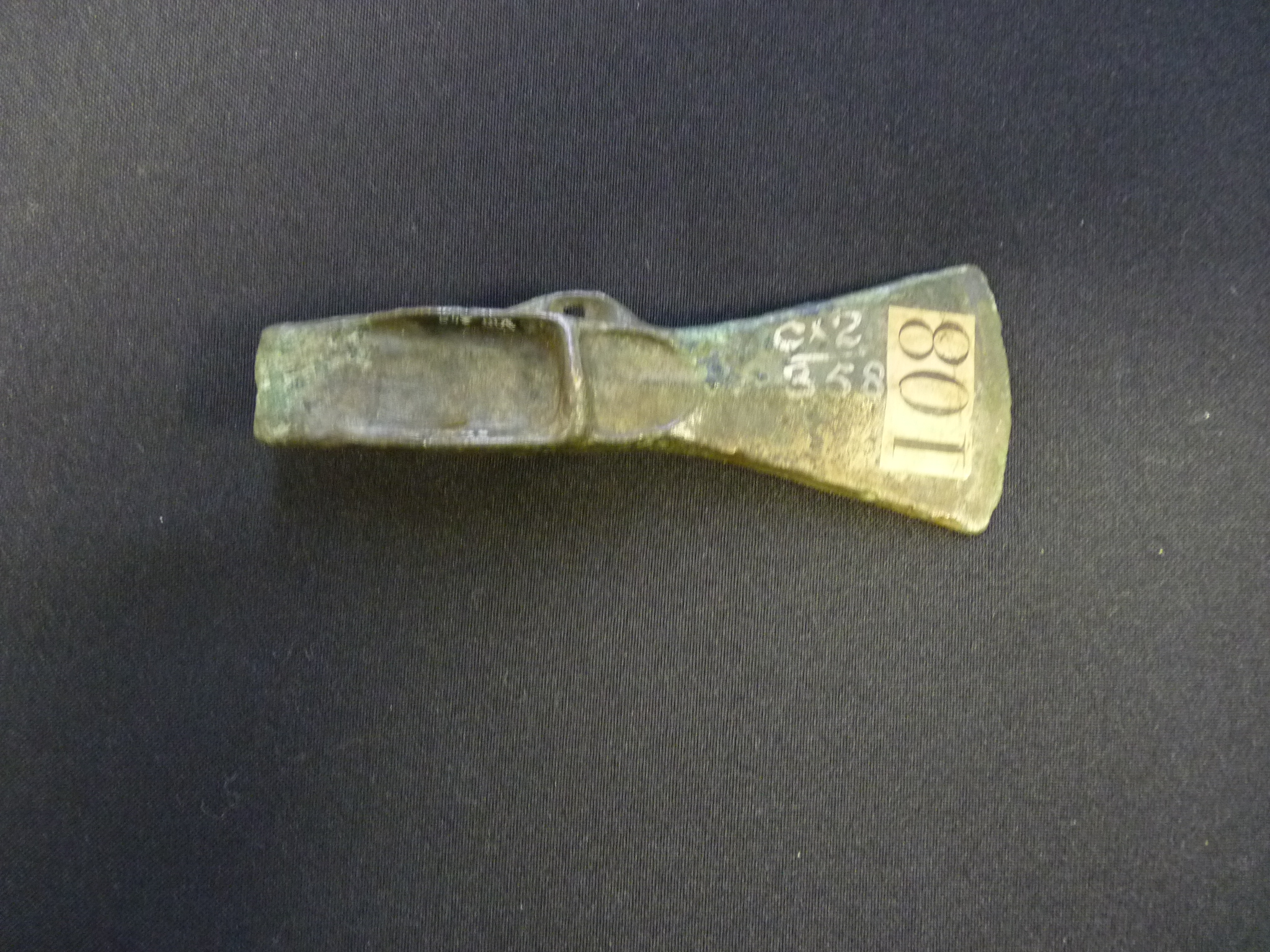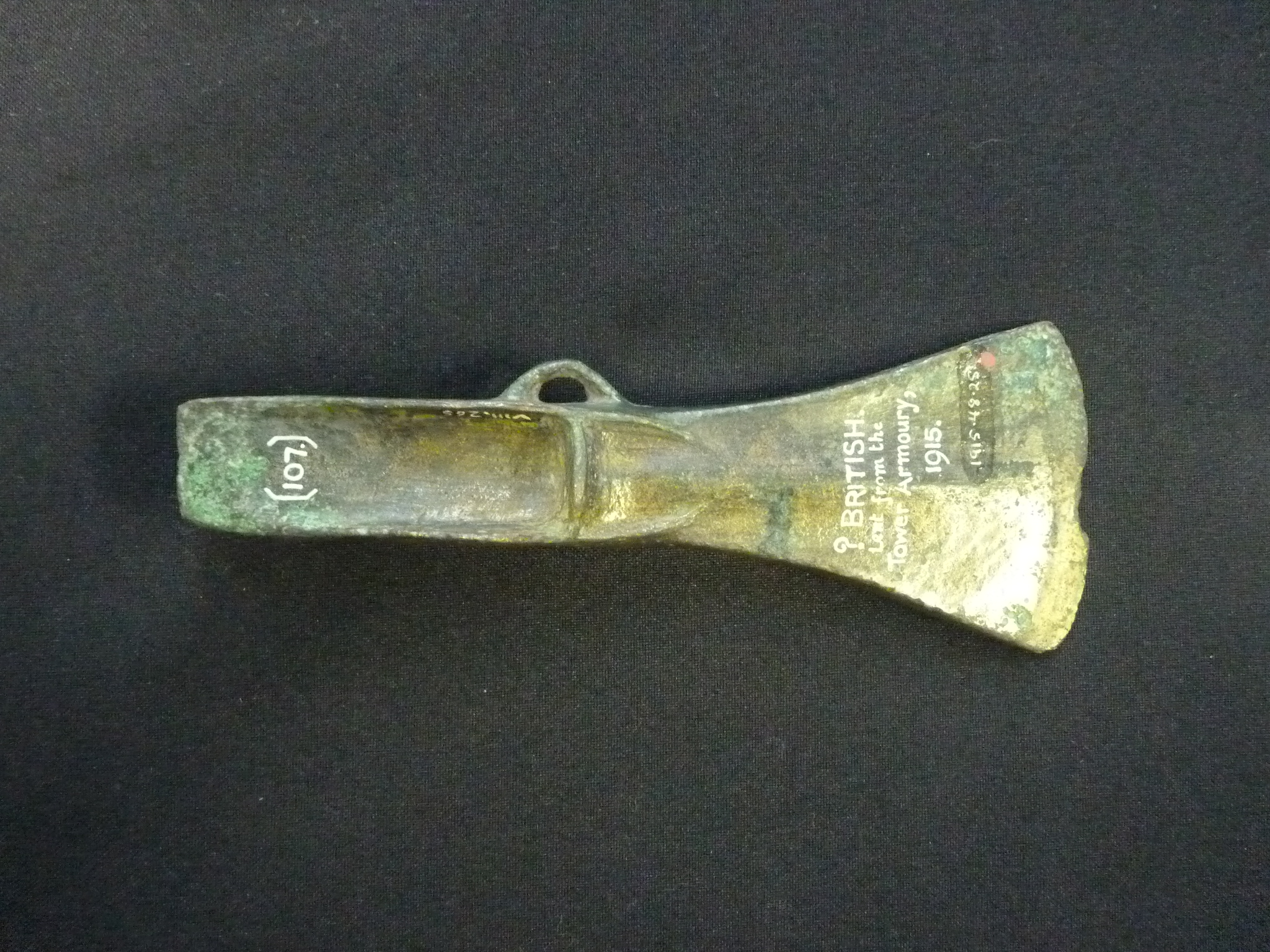 |  |  |
 |  |  |
 |  |  |
 |
Introduction
In 1839 a hoard of Bronze Age Palestave Axes Heads were found in Bramfield. Various reports have been made on this hoard, with differing numbers of axes reported. A number of axe heads have, probably, disappeared over time Those remaining are now in the Royal Armories, Leeds where we were fortunate to inspect them and to photograph them. Seven axe heads remain from the Bramfield Hoard. There were two other axe heads, cataloged as coming from Ireland, that resembled the Bramfield axe heads and may have been miss-cataloged in the past. We took photographs of these as well.
June Brereton has researched this hoard – here is her findings, which are her copyright. She is in the process of rewriting them:
BRONZE AGE
by June Brereton
When did new technology reach Bramfield? Was Bramfield at the cutting edge of the development of the use of metal? Perhaps not, but innovative methods did not pass us by! Although we do not have any Bronze Age field monuments actually in the parish, there are the ploughed out remains of ring ditches in Thorington, Wenhaston and Hinton; which is as good as being in Bramfield as of course there were no ecclesiastical boundaries at that time.1So it seems that people had indeed found the local terrain attractive to settle in and bury their dead.
BUT Bramfield had something much more tangible -one or possibly two hoards of bronze palstaves (axes). and the single find of one flanged axe head. The latter is a well recorded recent find on the southern border of the parish but there are two rather conflicting descriptions of the discovery of the hoard/s.
They differ in number, position and location, but relate to much the same time – about 1839. The Rev.Alfred Suckling2 tells us writing in 1845 that:
“about five or six years since, twelve large celts were discovered, not far from this spot, (the castle yard) lying in a circle, within which were eight smaller ones. They laid very near the surface of the earth and were turned up by a plough”.
Compare this with the description in the following letter preserved for us by the industry of David Elisha Davy, a 19c antiquarian.
Antiquarians were men, quite often parsons, who were well educated and at the time of expanding knowledge, fostered no doubt by the travels of the nobility and collections of classical artefacts, took a tremendous interest in their local history and preserved for us many documents, letters, and artefacts which would otherwise have been lost in the rush of the industrial expansion of the 19c.
This is a transcription of the letter copied by Davy for us:
Letter to Rev S. B. Turner of Halesworth dated Bramfield May 24th 1848.3
Sir,
Your having expressed a wish to have an account of axes found at Bramfield 8 or 10 years back , I have pleasure giving you the best account I can render.
A person named Robert Danbrook was spade draining in a meadow that had been broken up, on the property of Mr Capon, about a mile from the village on the side of the Turnpike leading from Bramfield to Yoxford and at about a depth of two feet he discovered 10 battle axes packed close together. I had the curiosity to purchase them of him for 25s. of which (sic) would be preserved in the Tower of London. The two largest I presented to my father who now holds them, being one of each pattern, there were two different patterns one of one kind and nine of the other but there were various sizes.
I am etc. Geo. Haward.
First, a word about George Haward, he was the son of Robert Haward, a substantial and respectable Bramfield farmer, Improprietor of Tithes and the founder of the chapel in Bramfield. I presume him to be a reliable source.
The particulars in the letter place the find land held by Mr Capon at the time of the Tithe Apportionment 1840.
It is not impossible that two hoards could have been found this close but it rather a mystery. The numbers in Mr Haward’s letter correspond very closely with the seven axes present in the Royal Armouries in Leeds (lately in the Tower of London) where I have actually handled them, and the two given to his father could be accounted for by two other axes known to have been in local museums leaving only one missing. The fate of the 20 celts (axes) described in Suckling is unknown. The other mention of the axes is from the Reverend Reginald Rabett quoted in Authorized Arms as saying that “and very singular battle axes have been found on my grounds”. Nowadays the axes are not regarded as ‘battle axes’ but more probably used for clearance of woodland in preparation for agricultural use.
This is the only hoard of middle bronze age artefacts to be found in the Halesworth area so far and the significance of the find is that it must mean that there was a settlement of some substance somewhere nearby as it was most probably the wealth of a head man that was buried for storage, as you will notice that they were ‘packed close together’. So there may have been some sort of cloth or leather container, long since vanished, to keep them safe. Nothing is known of the social set up here, but life was presumably very unreliable and perhaps the owner was never able to come back to collect his wealth.
Another possibility is that the hoard could have belonged to a travelling bronze smith but as the group did not include any new metal, broken axes or melted down tools for re-smelting this is less likely.
I showed the pictures of the palstaves to Francis Pryor a well-known authority on the Bronze Age and he advanced his theory that such a group could have been buried as a ritual offering in a watery place.
The site was probably rather boggy being where the stream from the higher land around South Manor Farm reached the bottom of the valley and turns north to run along below ‘Castle Yard’. In medieval documents the whole area from this point in to the village along the line of the present A144 was described as a brook, pasture or the lord’s chase. 4 I presume that the hoard was buried at some notable spot, such as a substantial tree or near a habitation site. The ground near the find site is very disturbed, gravel having been extracted and a distinct hollow has been formed so further investigation has been ruled out. Field walking has been carried out and no evidence of a habitation has been identified.
Come late Saxon times the name brunfeld appears as the forerunner of Bramfield and is given as meaning a clearing in the broom or brush.
People were moving about in the area and probably communicating with the settlements in Halesworth, Walpole, Wenhaston, Thorington and Hinton and creating tracks, some of which may still persist in our roads or footpaths today. It is generally accepted that clearance of the post glacial forest was taking place by 3,700BC so perhaps the origins of the clearing that paved the way for our village today started way back in the bronze age.
I have to say that personally I favour the second description (Haward) of the find to be the most accurate as it so closely tallies with the extant axes; also perhaps the very existence of the letter to the Rev Turner may indicate that there was some confusion locally about the provenance of the axes. The description by Suckling does seem extremely detailed too but the numbers are rather large to have disappeared so completely, and I wonder at the likelihood of a ploughman being able to see the circular pattern of the axes, without careful excavation techniques being employed. I wonder if they could have been stone axes, as suggested by W. A. Dutt.5 They would not have been deemed to have held much significance as if they had been bronze and there seems to have been no serious attempt to preserve them as with the bronze ones, by giving them to the British Museum. On the other hand the circular arrangement of the celts probably does reinforce the argument that they could be bronze as it is similar to the layout of other bronze hoards.
So, where does that leave us? With two bronze hoards? One hoard but misreported or perhaps one bronze and one stone hoard ?
1 celt could be axes or stones 2 no number mentioned. 3. RainbirdClark
